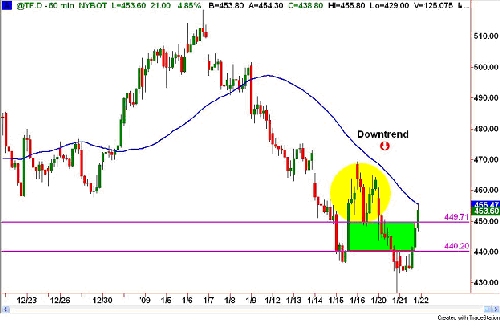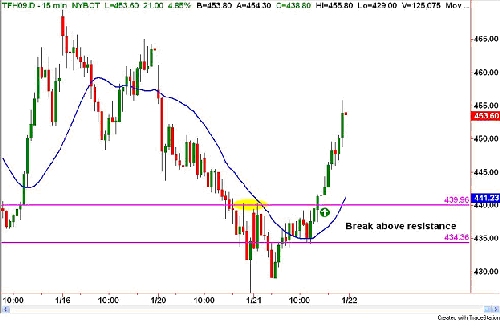One of the challenges a new trader faces - amongst many others - is finding the optimal time interval for the candlesticks being plotted on their charts. The trading approach or style one implements will of course, have a big influence. For instance, a swing trader (one who intends on holding positions for days and weeks) will have little use for, let's say, a 144-tick chart. On the other hand, a day trader may find tick charts an essential part of his analysis.
The most commonly used time frames are 1, 3, and 5-minute candles. When deciding which period to utilize, one must keep in mind that the shorter the time frame, the noisier the chart. In other words, the shorter time frames generate many more signals; however, those signals have a higher propensity to fail.
Traders that use ultra short-term charts (1 minute or less) are usually what we refer to in the industry as scalpers. These traders are in and out of the market in rapid-fire succession, typically taking 3 to 5 tick profits; they compensate for the high commission costs and the smaller profits by having a high win-to-loss ratio (usually over 80%). This type of trading is not something I recommend for the new trader, however. This is partly because this approach requires a high degree of skill, which can only be acquired through vast experience. This is not to say, that eventually, for those whose personalities are suited to this type of trading, and for the ones that develop the appropriate skill set, scalping may indeed become their bailiwick.
For those of us that look for bigger moves - on an intraday basis - observing several time frames simultaneously can be helpful in assisting to minimize risk and maximize our profit potential.
To this end, let's look at a recent example in the E-Mini Russell 2K (TF). Below is the hourly chart of the aforementioned TF. Note that the slope of the 50-period moving average is down, hence denoting a downward trend for this particular period. In addition, note the area highlighted in green. This is the distance between the first and second major resistance areas (the significance of this will become more apparent, as we progress through the trading example).
If we then drill down into the shorter time frame (15 and 5 minutes), we are able to spot a low risk entry within the confines of this bigger trend.
First, the fifteen-minute chart below helps us better define the break above the major resistance.

Secondly, the five-minute chart (shown below) gives us our trigger.

Here's the setup: The areas highlighted in yellow (440) are the most important because they show where the price had to break; once this level was pierced (highlighted in aqua) TF (E-Mini Russell 2k) rallied about a point and half before retracing (pulling back). The entry is on the retest, or a revisiting of the 440 level. A buy limit order is placed at 440.20 with a 10 tick ($100 per contract) stop loss. I prefer this entry rather than the breakout itself because of the market's susceptibility to false breakouts.
Additionally, from my experience, price has a very high probability of coming back to the original point of the breakout, thus making it a lower risk trade.
Now that we've defined the entry and risk in this example, we need to find a profit objective that comports with a sound risk-to-reward ratio.
For this, we turn back to the hourly chart and the colored (lime) area between the resistance lines. You might observe that once the 440-price line was broken, the next major level of resistance was not until roughly 449, which would be our first price target.
As you can see, this trade gave us an extremely favorable risk-to-reward ratio, and went well beyond the target. Granted, trades like this don't come along everyday; nonetheless, the best way to indentify them when they do setup is by implementing multiple time frame analysis. By utilizing the smaller time frames as "triggers" along with the longer time frames as "filters", you can open up more trading possibilities.
As a trader, you need to be cognizant of what the market is doing in all time frames, regardless of your style of trading. I find novice traders become myopic in the way they view the market, and by doing so, fail to spot good trades, and/or make bad ones.
So, try expanding your time horizons and perhaps your profits will follow suit.
Until next time, I hope everyone has a profitable week.
The most commonly used time frames are 1, 3, and 5-minute candles. When deciding which period to utilize, one must keep in mind that the shorter the time frame, the noisier the chart. In other words, the shorter time frames generate many more signals; however, those signals have a higher propensity to fail.
Traders that use ultra short-term charts (1 minute or less) are usually what we refer to in the industry as scalpers. These traders are in and out of the market in rapid-fire succession, typically taking 3 to 5 tick profits; they compensate for the high commission costs and the smaller profits by having a high win-to-loss ratio (usually over 80%). This type of trading is not something I recommend for the new trader, however. This is partly because this approach requires a high degree of skill, which can only be acquired through vast experience. This is not to say, that eventually, for those whose personalities are suited to this type of trading, and for the ones that develop the appropriate skill set, scalping may indeed become their bailiwick.
For those of us that look for bigger moves - on an intraday basis - observing several time frames simultaneously can be helpful in assisting to minimize risk and maximize our profit potential.
To this end, let's look at a recent example in the E-Mini Russell 2K (TF). Below is the hourly chart of the aforementioned TF. Note that the slope of the 50-period moving average is down, hence denoting a downward trend for this particular period. In addition, note the area highlighted in green. This is the distance between the first and second major resistance areas (the significance of this will become more apparent, as we progress through the trading example).
If we then drill down into the shorter time frame (15 and 5 minutes), we are able to spot a low risk entry within the confines of this bigger trend.
First, the fifteen-minute chart below helps us better define the break above the major resistance.

Secondly, the five-minute chart (shown below) gives us our trigger.

Here's the setup: The areas highlighted in yellow (440) are the most important because they show where the price had to break; once this level was pierced (highlighted in aqua) TF (E-Mini Russell 2k) rallied about a point and half before retracing (pulling back). The entry is on the retest, or a revisiting of the 440 level. A buy limit order is placed at 440.20 with a 10 tick ($100 per contract) stop loss. I prefer this entry rather than the breakout itself because of the market's susceptibility to false breakouts.
Additionally, from my experience, price has a very high probability of coming back to the original point of the breakout, thus making it a lower risk trade.
Now that we've defined the entry and risk in this example, we need to find a profit objective that comports with a sound risk-to-reward ratio.
For this, we turn back to the hourly chart and the colored (lime) area between the resistance lines. You might observe that once the 440-price line was broken, the next major level of resistance was not until roughly 449, which would be our first price target.
As you can see, this trade gave us an extremely favorable risk-to-reward ratio, and went well beyond the target. Granted, trades like this don't come along everyday; nonetheless, the best way to indentify them when they do setup is by implementing multiple time frame analysis. By utilizing the smaller time frames as "triggers" along with the longer time frames as "filters", you can open up more trading possibilities.
As a trader, you need to be cognizant of what the market is doing in all time frames, regardless of your style of trading. I find novice traders become myopic in the way they view the market, and by doing so, fail to spot good trades, and/or make bad ones.
So, try expanding your time horizons and perhaps your profits will follow suit.
Until next time, I hope everyone has a profitable week.
Last edited by a moderator:
